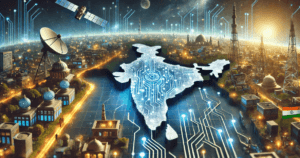How Modi’s Leadership is Shaping India’s AI Future Amid Global Tech Rivalry
Prime Minister Narendra Modi recently highlighted India’s crucial role in AI during his conversation with Lex Fridman, underscoring the global technology race between the U.S. and China. As India strives to become a leading scientific and technological power by 2047, its success will depend on how effectively emerging technologies are integrated across society. While Digital Public Goods have played a significant role in large-scale technology diffusion, the impact of leadership in driving this transformation is often overlooked.
Modi’s leadership has accelerated the adoption of digital solutions nationwide, with a key example seen during the COVID-19 pandemic. During this crisis, technology played a vital role in managing public health responses and delivering essential services efficiently. AI and digital infrastructure were leveraged to reach millions, ensuring inclusive access to resources. Strategic leadership continues to drive India’s tech expansion, setting an example for other developing nations.

How Modi’s Leadership is Shaping India’s AI Future Amid Global Tech Rivalry
In a recent conversation with podcaster Lex Fridman, Prime Minister Narendra Modi reaffirmed India’s commitment to leading global advancements in artificial intelligence (AI). He emphasized that regardless of how AI evolves worldwide, India will play a crucial role in shaping its future. This statement underscores the country’s ambition to establish itself as a major player in the tech landscape, currently dominated by the U.S. and China. Modi’s remarks also align with India’s broader goal of becoming a global leader in science and technology by 2047, marking its 100th year of independence. However, achieving this vision will depend on how effectively India adopts emerging technologies, ensures their widespread implementation, and leverages them to drive economic and social progress.
The global tech race is currently defined by intense competition between the U.S. and China, with both nations investing heavily in AI, quantum computing, and other cutting-edge fields. India’s strategy, as outlined by Modi, prioritizes inclusivity and accessibility. Unlike the zero-sum rivalry between existing superpowers, India aims to integrate technology into daily life for the benefit of its vast population. Initiatives such as Digital Public Goods (DPGs)—open-source tools and platforms designed for mass adoption—have already revolutionized key sectors like finance and healthcare. The success of Aadhaar (a biometric ID system) and UPI (a real-time payment network) demonstrates how technology can address large-scale challenges, from reducing bureaucratic inefficiencies to enabling seamless financial transactions for millions.
Despite India’s technological progress, discussions often overlook the crucial role of leadership in driving these transformations. Modi’s government has prioritized digital infrastructure as a public good, ensuring that even marginalized communities can access essential services such as banking, education, and healthcare via smartphones and internet connectivity. This approach extends beyond mere innovation—it is fundamentally about governance. A striking example was seen during the COVID-19 pandemic, when technology became a critical tool for crisis management. The CoWIN platform streamlined vaccine distribution, allowing citizens to book appointments and receive digital certificates. Telemedicine apps bridged gaps in healthcare access, while contact-tracing tools helped contain outbreaks. These efforts showcased how proactive leadership can turn technology into a powerful force for resilience during emergencies.
However, significant challenges remain. Bridging India’s digital divide—between urban and rural areas, or between tech-savvy youth and older generations—requires more than just infrastructure. It necessitates education, awareness, and policies that empower individuals to confidently adopt digital solutions. For instance, while UPI has revolutionized digital payments, small businesses in remote villages still need support to transition to cashless transactions. Similarly, AI’s potential in agriculture and climate action can only be realized if farmers and local communities receive the necessary training to interpret data and apply technological solutions. Modi’s vision, therefore, hinges on democratizing technology—making it affordable, user-friendly, and relevant to everyday needs.
Looking ahead, India’s journey toward becoming a global tech powerhouse will rely on three key pillars: innovation, implementation, and inclusion. Startups and research institutions are already making strides in AI, space technology, and renewable energy. However, technological breakthroughs will have little impact unless they reach those who need them most. This is where India’s focus on DPGs becomes a game-changer. By treating technology as a shared resource rather than a luxury, the country is laying the foundation for sustainable and inclusive growth. At the same time, global collaborations—with Silicon Valley firms, European nations, and other key players—will be essential for maintaining an edge in innovation.
Ultimately, Modi’s confidence in India’s tech future isn’t just about competing with superpowers—it’s about reshaping the global narrative of progress to ensure that technology uplifts all segments of society. The pandemic demonstrated that with strong leadership and strategic policies, even the most complex challenges can be tackled through innovation. As India works toward its 2047 development goals, one thing is clear: technology is not just a driver of economic growth—it is a bridge to equity, opportunity, and a better quality of life for all. The world will be watching to see how this ambitious vision unfolds.
You must be logged in to post a comment.